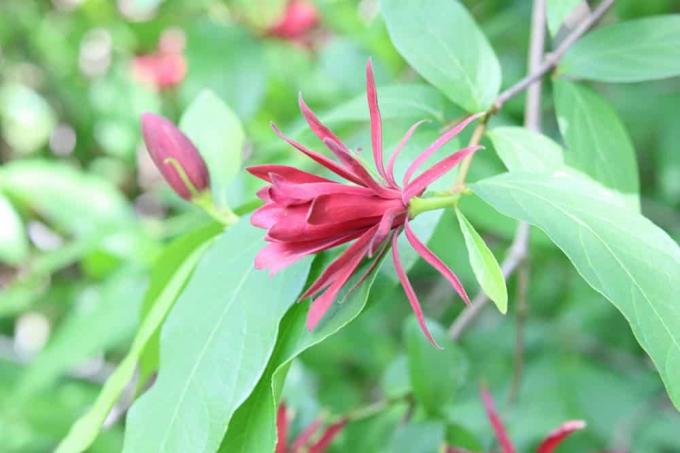

Table of contents
- Cut
- multiply
- To harvest
- dry
A herb bed not only enriches the garden or balcony visually, but also practically. Especially when plants like the Moroccan olive herb thrive in it. Proper care is essential for the cultivation to produce a bountiful harvest. But how should the gardener prune Santolina viridis? And what happens after harvesting? Are the spicy stems suitable for drying? The gardener will find answers to these questions and four different instructions for propagating the olive herb in this guide.
Cut
Tip 1: timing
Anyone who has just planted their olive herb should give the plant some time to get used to the location. Otherwise it can happen that the perennial plant only yields a crop once. After just two weeks, the herb has usually developed strong roots. However, the first pruning should only be done in the second year of growth.
Tip 2: Protect from woody growth
The evergreen Santolina viridis tends to become woody. A rejuvenation pruning in spring or fall counteracts the process. The more lignified the shoots, the less deep the gardener sets the scissors.
Tip 3: Technology
Since Santolina viridis sprout for several years, pruning is the same as for conventional perennials:
- Cut it in half or at most a third
- Remove faded stems completely
- Shorten growing shoots only slightly (to half or a third)
- never cut into the old wood (put the scissors at least 1 cm above it)
- Cut thick stalks at an angle so that rainwater can run off
A notice:
Since olive herb is very tolerant of cutting, it is ideal for keeping in buckets.
multiply

Tip 4: Propagation by seed
- Remove seeds in late summer after flowering
- leave to dry in a warm place
- Store in an airtight container until spring
- start sowing in February at the earliest
- Soak seeds in water for 24 hours
- Fill the growing pot with nutrient-poor substrate
- Press the seeds lightly into the soil
- Transplant seedlings when they are of appropriate size
A notice:
Direct sowing outdoors is not recommended, as the seeds are likely to fall victim to voracious snails and birds.
Tip 5: Promote germination
- Olive herb is cold germ - needs cold stimulus
- Fill plastic bag with sand
- put in seeds
- Store in a cool place (e.g. in the refrigerator) for 3 to 4 weeks
Tip 6: Propagation by division
- Dig up mother plant in spring
- Divide root with a sharp knife
- plant again
- Planting distance: 30 cm
Tip 7: Propagation by lowering
- Works well because drooping shoots
- Draw a gutter next to the plant
- push in a shoot
- cover with earth
- Branch tip looks out of the ground
- fix with a stone
- Cut off new shoots when they are 10 cm long
- plant in another place
Tip 8: Propagation by cuttings
The best time to take the cuttings is spring. Since Santolina viridis forms roots relatively slowly, a rooting powder is recommended. The gardener can obtain this from specialist shops.
- Mix rooting powder with soil and sand
- put in small pots
- Take 20 cm long, slightly woody cuttings
- Remove leaves from the bottom of the stem
- put in the pots
- pour on
- put a clear plastic bag over the pot (keeps the moisture in)
- Pour in when there are no more water droplets on the bag
- prick out after two weeks
- only put outdoors after the night frosts have subsided
Tip 9: Make your own alternative rooting powder
The commercially available rooting powder usually comes from synthetic production. Chemical additives are therefore not excluded. With simple household remedies, however, the gardener manages to produce a comparable alternative.
- Collect fresh, tender willow leaves or scrape off the willow bark (about 3 cups), chop finely, pour over boiling water, allow the brew to steep and then collect
- Dip the stem end of the cuttings in cinnamon
- Mix 1 tablespoon of apple cider vinegar in 6 cups of water and dip the cuttings in it
- Dip cuttings in honey
- Dissolve an uncoated aspirin tablet in water and place the cutting in it for a while
- Drill a hole in a potato and insert the cutting
- Dissolve 1 tablespoon of aloe vera juice in water, place the cuttings in for about a week
- Pour lukewarm water over 100 g of dry yeast and place the cuttings in it
A notice:
Anyone who decides against their own propagation and has already purchased their plant from the nursery should definitely pay attention to the substrate when buying it. Mostly herbs from the specialist trade are doused. Since Santolina viridis does not tolerate waterlogging, this care error will sooner or later have an effect. Moss in the plant pot is a clear sign of poor quality.
To harvest
Tip 10: Harvest time
Once the plant has become accustomed to its location, the gardener can harvest it permanently. Santolina viridis feels most comfortable
- in a full sun location
- in well-drained soil
- in predominantly sandy, nutrient-poor soils.
- the best time to harvest is in the morning.
Tip 11: Combine harvest and pruning

The branches of the olive herb taste best fresh. Therefore, it is advisable to always cut off the stems in required quantities. One or two stems are often enough for culinary use. However, there is nothing wrong with completely cutting back the plant. On the contrary, in this process the gardener promotes a bushier growth through branching. Cutting back the shoot tips by a few centimeters is enough for this.
dry
Tip 12: Air drying
The gardener ties the branches together in individual bundles and hangs them upside down. The place should
- shady
- warm
- protected
- and airy
be. Once all the moisture has evaporated, he wipes off the leaves and puts them in an airtight bag.
Tip 13: Drying in the oven
The faster option is drying in the oven. To do this, the gardener spreads the branches out on a baking tray and heats the oven to around 40°C. The door should be left ajar to allow moisture to escape.
Tip 14: Drying in the dehydrator
- Distribute branches on the tiers
- select the appropriate program
A notice:
The dried branches of the olive herb can be used in a variety of culinary ways. However, the loss of aroma due to the drying process cannot be avoided with any of the methods mentioned. In order to keep this as low as possible, drying should take place at a low temperature in the most gentle way possible. The gardener should therefore only dry the branches to stock up or to preserve the spice in the event of an accidental over-crop. Otherwise, fresh consumption is recommended.
Tip 15: Other types of preservation
The taste of the leaves of the olive herb is reminiscent of the Mediterranean cuisine. Some people compare the aroma with thyme, others clearly recognize the relationship to the olive. Santolina viridis can therefore be processed in a similar way to the oil fruit. For example
- pickled in brine
- soaked in oil
- pickled in vinegar
- made into pesto
- frozen
 garden editorial
garden editorial I write about everything that interests me in my garden.
Learn more about herbal recipes

Make herbal lemonade yourself | 12 delicious recipes
Herbal lemonades are delicious, thirst-quenching and healthy and easy to make yourself with the right recipe. A long-lasting supply can be built up with homemade syrup made from herbs. At Hausgarten.net you will find the best recipes to make yourself.

Real spice bush, Calycanthus floridus: care from A to Z
The spice bush brings a spicy scent to the garden. It is reminiscent of cinnamon, camphor and other spices. In the flowering period, it looks very attractive with its rust-red flowers. Caring for the garden is not very demanding. There are tips on how to do this in the guide.

Make herbal salt yourself | 7 recipes for fresh & dried herbs
Making herbal salt yourself is easy and practical. Because fresh herbs can easily be preserved with it and an individual spice mixture can be prepared. Suitable recipes for fresh and dried herbs can be found here.

Colakraut Syrup - How to make cola without caffeine & 4 delicious recipes
Colakraut is also known under the name southernwood and has - as the name already suggests - an intense cola aroma. With the right recipes, syrup, lemonade and liqueur can be made from it. Here we tell you how you can do it yourself.

Make your own herbal liqueur 5 recipes for herbal schnapps
After a hearty meal or when you have a stomach ache, a herbal schnapps works wonders. Icons in the herbal liqueur heaven, such as Jägermeister and Ramazotti, demonstrate a variety of pleasure variations and strictly guard their legendary recipes. These 5 recipes for herbal schnapps reveal how you can easily make the beneficial spirit drink yourself.

Salad herbs: 11 classic herbs for the salad | make mix
If you like to eat salad, you also need a lot of herbs for the good taste. The mixture is quick and easy to make yourself, especially if the salad herbs are growing in your own garden bed or window box. The salad can be designed so that it tastes different again and again.
